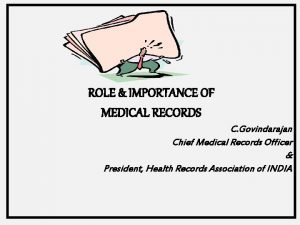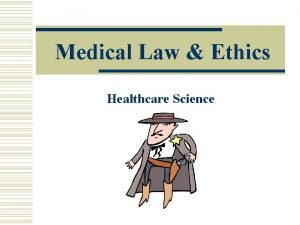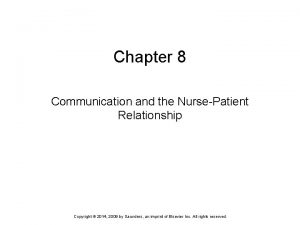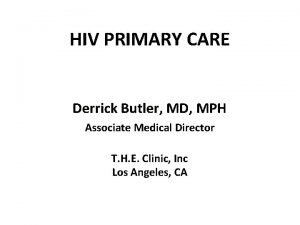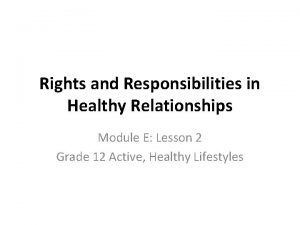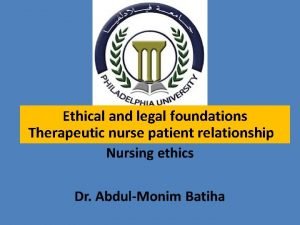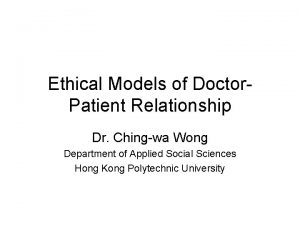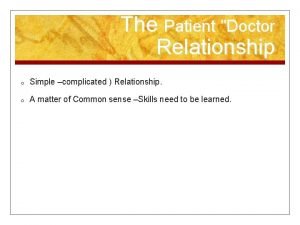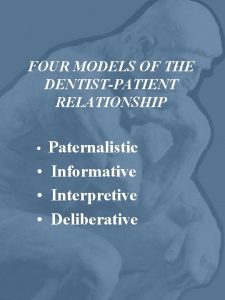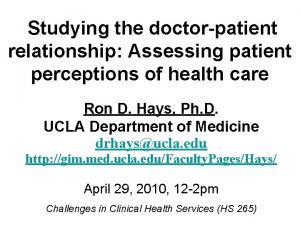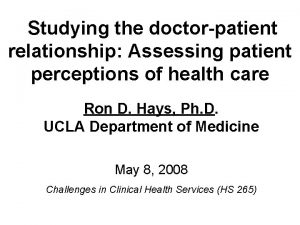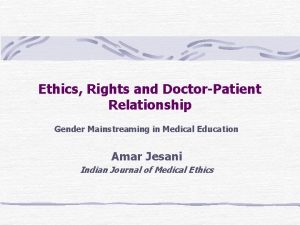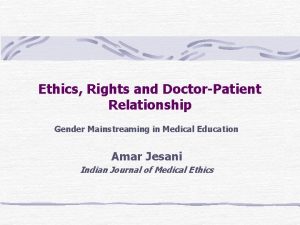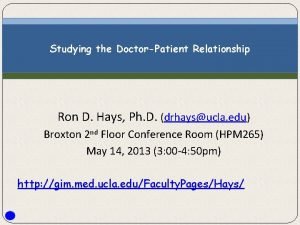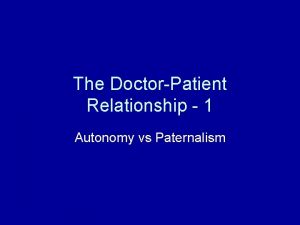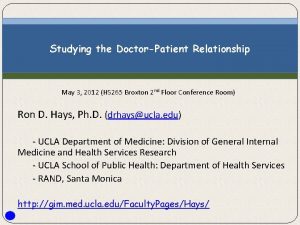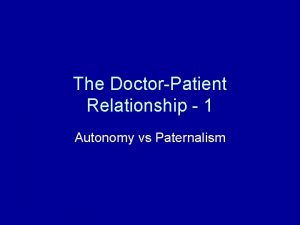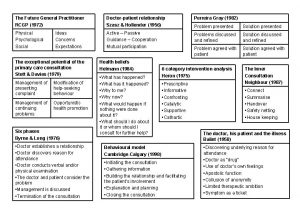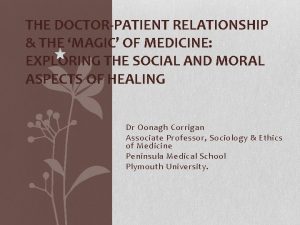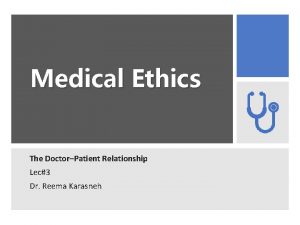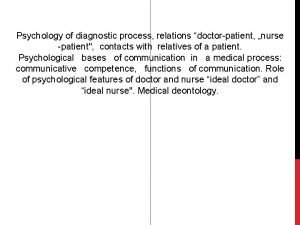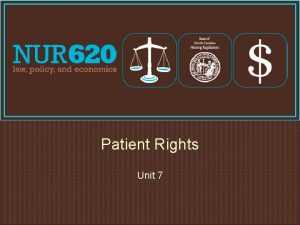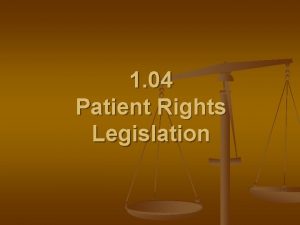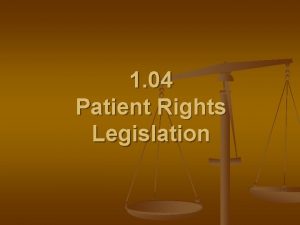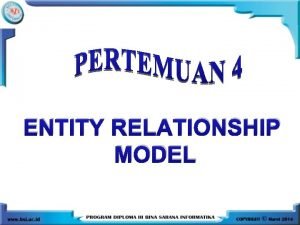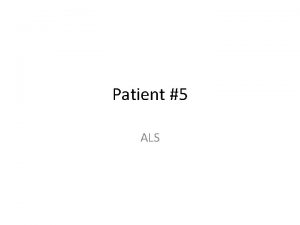Patient rights and Doctorpatient relationship Dr Derrick K




































- Slides: 36

Patient rights and Doctor-patient relationship 病人權利與醫患關係 Dr. Derrick K. S. Au 區結成醫生 Kowloon Hospital & Hong Kong Eye Hospital

The oldest code of medical ethics: Hippocratic Oath (4 th Century BC) Several parts of the oath have been revised over the years, e. g. “To consider dear to me, as my parents, him who taught me this art; to live in common with him and, if necessary, to share my goods with him…” “Nor will I give a woman a pessary to procure abortion; ” “I will not cut for stone, even for patients in whom the disease is manifest; I will leave this operation to be performed by practitioners, specialists in his art. ”

Code of Professional Conduct (Hong Kong Medical Council) Medicine as a profession is distinguished from other professions by a special moral duty of care to save lives and to relieve suffering. Medical Registration Ordinance (Cap. 161) confers upon the medical profession considerable freedom of self regulation, the profession is obliged to abide by a strict code of conduct which embodies high ethical values, protects patients’ interests, and upholds professional integrity. Trust is essential to the practice of medicine. There can be no medicine in the absence of trust. The patient’s trust imposes upon the doctor a corresponding duty to be trustworthy and accountable. http: //www. mchk. org. hk/code. htm

Ethics: What is right? Moral (道德)- comes from Latin ‘mos’(mores); Ethics (倫理) - comes from Greek ‘ethos’ Both have meaning of customs (風俗), or generally accepted social norm But ‘What is right’ is not just a matter of social norm (e. g. slavery was a social norm at one time) Professional norm is not always right, it does revise over time What is legally permitted is not always

Ethical principles Commonly quoted ethical principles: – Autonomy 自主原則 – Beneficence 行善原則 – Justice 正義原則 – Nonmaleficence 不傷害原則 These are useful but by themselves are not adequate for ethical decision making

Rights The great religions of the world have all sought to establish moral codes of conduct based on divine law. These are often concerned with the duties and obligations of man to his fellow human beings, to nature, to God and the whole of creation. [Ancient Chinese moral philosophers like Confucius (孔子) and Mencius (孟子) are concerned with similar moral issue, though not as a part of divine law ] The idea of 'human rights' is not universal - it is essentially the product of 17 th and 18 th century European thought. Such secular conception of rights emphasised duties and privileges that arose from peoples' status or relationships, rather than abstract rights in the philosophical sense. Since 1948, with the Universal Declaration of Human Rights, . Respect for human rights is becoming a universal principle of good government. http: //www. universalrights. net/main/histof. htm

Rights / Obligations A paired concept, for instance: – People / Government – Patient / Doctor – Human being / fellow human beings Commonly quoted universal human rights: – – – right to life; right to freedom; right to own property (limiting where government may intrude); citizenship rights (voting, nationality and participation in public life); rights to standards of good behaviour by governments (or protection of the rule of law); Other social, economic and cultural rights have become important during the 20 th century, and raise important and still controversial issues about social justice and the distribution of wealth. http: //www. universalrights. net/main/histof. htm

WHO: Patient rights understood as one aspect of basic human rights World Health Organisation: Formalized in 1948, the Universal Declaration of Human Rights recognizes “the inherent dignity” and the “equal and unalienable rights of all members of the human family”. And it is on the basis of this concept of the person, and the fundamental dignity and equality of all human beings, that the notion of patient rights was developed. In other words, what is owed to the patient as a human being, by physicians and by the state, took shape in large part thanks to this understanding of the basic rights of the person. http: //www. who. int/genomics/public/patientrights/en/


WHO: Patient rights can vary in different countries World Health Organisation (WHO): Patients' rights vary in different countries and in different jurisdictions, often depending upon prevailing cultural and social norms. Different models of the patient-physician relationship —which can also represent the citizen-state relationship—have been developed, and these have informed the particular rights to which patients are entitled. http: //www. who. int/genomics/public/patientrights /en/

Patient’s Charter (病人約章) In year 2000, the Hong Kong Hospital Authority produced a Patient’s Charter to outline patient rights and responsibilities in public hospital

HA Patients’ Charter – Patients’ rights Right to Medical Treatment (醫治 權) Right to Information (知悉權; 知情 權) Right to Choices (決定權 ) Right to Privacy (私隱權 ) Right to Complaint (申訴權)

HA Patients’Charter – Patients’ Responsibilities Give your heath care providers as much information as you can about your present health, past illnesses, any allergies… Follow the prescribed and agreed treatment plan, and conscientiously comply with the instructions given. Show consideration for the rights of other patients and health care providers, by following the hospital rules concerning patient conduct. Keep any appointments that you make, or notify the hospital or clinic as earlyl as possible…. Should not ask health care providers to http: //www. ha. org. hk/charter/pceng. htm provide incorrect information, receipts or

Hong Kong Medical Association's Patients' Rights and Responsibilities: To play an active and responsible role in the healthcare process, you should – be frank to your doctors in revealing your medical conditions. – endeavor to co-operate with any agreed form of management. – be well informed by your insurers of the detailed scope of coverage of your medical insurance policies. – not request doctors to issue incorrect receipts, certificates or document, or to make incorrect entry into the medical records. – be responsible to meet the required fees and charges for the medical services provided to

HKMA Patients’ rights Right of information. - Charges - Drugs. Right of refusal Right of confidentiality Medical Reports - Public medical institutions. - Private hospitals and practitioners Complaints - Public medical institutions. - Private hospitals and practitioners Operations - Public and Private Medical Institutions

HKMA: Right of Information A patient should have a reasonable and balanced understanding of the sickness he is suffering from. You may enquire about what disease you have, if you need any further examination, and how to cure the disease. You should also know what treatment you will receive, whether with drugs or operation, any side effects after treatment, and the chances of recurrence. In other words, in order to know more relevant facts about your sickness, you should consult your attending doctor.

In the U. S. Definition Patient rights encompass legal and ethical issues in the provider-patient relationship, including a person's right to privacy, the right to quality medical care without prejudice, the right to make informed decisions about care and treatment options, and the right to refuse treatment. Many issues comprise the rights of patients in the medical system, including a person's ability to sue a health plan provider; access to emergency and specialty care, diagnostic testing, and prescription medication without prejudice; confidentiality and protection of patient medical information; and continuity of care. http: //www. answers. com/topic/patient-rights

The U. S. Patient’s Bill of Rights Health care reform led to an emergence of health maintenance organizations (HMOs) and other managed health care plans. The rapid change in medical care moved health care decision making from medical professionals to business entities, a move many consider to be detrimental to the health care industry in general. Establishing a patient's bill of rights has been the response to this concern. The Bipartisan Patient Protection Act of 2001 has been debated and passed by the U. S. Senate and the U. S. House of Representatives and signed into law.

In the U. S. Bill of Rights These basic rights include the right to: – participate in the development and implementation in the plan of care – be treated with respect and dignity – be informed about condition, treatment options, and the possible results and side effects of treatment – refuse treatment in accordance with the law, and receive information about the consequences of refusal – quality health care without discrimination because of race, creed, gender, religion, national origin, or source of payment – privacy and confidentiality, which includes access to medical records upon request – personal safety – know the identity of the person treating the patient, as well as any relationship between professionals and agencies involved in the treatment – informed consent for all procedures – information, including the medical records by the patient or by the patient's legally authorized representative and hospital charges, except for Medicaid and general assistance – consultation and communication – complain or compliment without the fear of retaliation or compromise of

What is happening to the doctor-patient relationship? Some doctors are worried that the physician-patient relationship, a special humanism motivated by tradition and governed by the ethics of medicine, may be fouled up by the fiscal and economic constraints likely to occur in the health care system - Alvan Feinstein, MD, professor of medicine, Yale University School of Medicine, New Haven, Conn. Marwick, Charles. Preservation of Physician-Patient Relationship Seen as Integral to Health Care System Reform JAMA The Journal of the American Medical Association. Volume 271(12), 23 March 1994, pp

William C. Hsiao: William C. Hsiao, Ph. D, Department of Health Policy and Management, Harvard School of Public Health, Boston, Mass. "We have promoted the diffusion of some technologies that may not be cost-effective and encouraged their overuse…" "Furthermore, we undercompensate primary care physicians, discouraging them from rendering their services, and likewise (fail to encourage) the young medical school graduates to pursue a career in family care. "Instead of trying to align the economic incentives to improve cost-effectiveness, we are creating an administrative organization that will intrude on this very personal relationship between doctor and patients, between the caring physician with the technical expertise and the patient, " Marwick, Charles. Preservation of Physician-Patient Relationship Seen as Integral to Health Care System "Is. Reform that the best we can do to preserve this unique JAMA The Journal of the American Medical Association. Volume 271(12), 23 March 1994, pp

Models of Doctor-Patient Relationship There are three different kinds of models: 1. PATERNALISTIC (家長式關係) 2. CONTRACTUAL (合約關係) 3. FIDUCIARY (受託關係; Fiduciary duty: 受託 責任) http: //www. carroll. edu/~msmillie/bioethics/modelsdocpatrelation. htm

Fiduciary relationship in peril? Over the ages the doctor-patient relationship has been defined, through rules of ethics and rules of law, as a fiduciary one, as a relationship founded in trust. When a patient seeks a physician’s help and the physician agrees to give that help, a special covenant is made. The patient agrees to take the physician into her confidence, to reveal to him even the most secret and intimate information related to her health. The physician, in turn, agrees to honor that trust, and to become the patient’s advocate in all matters related to her health, placing her interests above all others - including his own personal or financial concerns. The loss of this doctor-patient relationship has obvious consequences for patients. Patients, when they are sick and thus least able to fend for themselves, are left without a true, dedicated advocate as they try to navigate the hostile halls of the healthcare system, whose chief concern is to find ways of not spending money on them. Loss of the traditional doctor-patient compact leaves patients marginalized and floundering within that The Importance of the Doctor-Patient and Why We Can’t Have It Anymore system at the time they are most. Relationship, vulnerable. Posted on January 23, 2009 - Blog of Dr. Rich

Paternalistic model: Strengths and Weaknesses Paternalistic model: The doctor is the professional. He/she gives the order, the patient obeys. Strengths: Emphasizes the expertise and knowledge of the doctor Weaknesses: – Ignores the autonomy of the patient – Ignores non-health related but morally legitimate values of the patient

Contractual model: Strengths and Weaknesses Contractual model: The doctor and patient "contract" for each other's mutual benefit; the patient determines or agrees to the doctor’s decisions. Strengths: – Highlights the autonomy of both patient and physician – Acknowledges cooperative/shared aspects of medical decision-making Weaknesses: – No "contracts" developed or signed in real doctor/ patient relationships – Model doesn’t allow for at trusting relationship

Fiduciary model: Strengths and Questions Fiduciary model: The patient confidently entrusts his/her health care to the doctor, who takes on the obligation of working for the benefit of the patient (Fiduciary: relates to a holding of something in trust for another) Strengths: – Preserves the freedom and autonomy of both patient and physician – The legitimate role of physician knowledge – The important role of trust in the doctor/patient relationship Questions raised by skeptics: 1. Patient trust may be manipulated for further economic gain. 2. Patient trust may undermines consumer’s awareness of need for self-protection

What about Chinese Culture? Traditional Chinese medical ethics emphasizes 醫德, based on virtues and morality, rather than relationship between two autonomous individuals Patients as children (醫者父母心) is related to the ideal image of a benevolent ruler (愛民如子) It may be analogous to the concept of guardianship (監護) in Western culture

A few cases for thought

Case 1: Refusal of treatment Chest physiotherapy is prescribed for an elderly cancer patient by the attending doctor, but he refuses. Must the physiotherapist insist on carrying out the treatment plan? Is it unethical to go against the patient’s wish (to refuse)?

Case 2: Autonomy and family member A patient’s son insisted that the doctor should not tell his mother that she has been diagnosed with chronic leukemia, otherwise he will take her home against medical advice. The mother seems to be generally passive and submissive to the son’s decisions related to her health care How should the patient’s right be addressed?

Case 3: Demand of Alternative Medicine (另類療法) A 20 year old patient with severe head injury from traffic accident did not improve with rehabilitation. He cannot comprehend or communicate The mother demands the hospital to provide hyperbaric oxgyen therapy (high pressure oxygen treatment in a closed chamber) What is the extent of the mother’s right in this case? How should the patient’s rights be

Case 4: Demand of medical treatment A patient with mental illness demanded to be treated with the newest psychiatric drugs The doctor assessed and found that the patient was not suffering from significant side effect from the existing drug, which is also one of the newer drugs that had passed the patent period (cheap generic drug is locally

Case 5: Right to die? A tetraplegic patient on chronic assisted ventilation wrote to the HKSAR CE to demand legislation for patient’s right to die and to legalise euthanasia (安樂死) Does a patient have ‘right to die’?

Dealing with refusal of treatment When mentally competent and properly informed, the patient’s refusal must be respected. [Principle of respect for autonomy] Assess mental capacity (精神上的行為能力) Provide adequate and appropriate information Treatments can be provided to mentally incapacitated persons (精神上無行為能力的 人 ) based on ‘best interests’ (病人的最佳 利益) principle [Principle of beneficience]

Resolving ethical dilemma related to autonomy – advice for clinicians Listen carefully – do not jump to conclusion of “patient not cooperative” too easily Gather more information relevant to the case situation Consider your own bias and assumptions Explore reasonable options of compromise Involve carers and friends trusted by

Thank you for your attention
 Role of medical records
Role of medical records Patient rights and responsibilities nabh
Patient rights and responsibilities nabh Positive vs negative rights
Positive vs negative rights Conclusion of rights
Conclusion of rights Legal rights and moral rights
Legal rights and moral rights Negative right
Negative right Patient 2 patient
Patient 2 patient Rights of the patient in hospital
Rights of the patient in hospital Rights of the patient in hospital
Rights of the patient in hospital Rights of the patient in hospital
Rights of the patient in hospital Therapeutic communication techniques
Therapeutic communication techniques Littoral real estate
Littoral real estate Negative rights vs positive rights
Negative rights vs positive rights Negative rights
Negative rights Negative rights vs positive rights
Negative rights vs positive rights Guy derrick crane
Guy derrick crane Alton brown turkey derrick
Alton brown turkey derrick Dr derrick butler
Dr derrick butler Barbara derrick
Barbara derrick Derrick whitehead
Derrick whitehead Derrick hasterok
Derrick hasterok Youtube derrick 1973
Youtube derrick 1973 Derrick swistak
Derrick swistak Derrick herndon
Derrick herndon Derrick kearney
Derrick kearney Derrick fulton
Derrick fulton New joshua generation
New joshua generation Derrick hindery
Derrick hindery Responsibilities in a relationship
Responsibilities in a relationship Doctor patient relationship ethics
Doctor patient relationship ethics Phases of nurse patient relationship
Phases of nurse patient relationship Phases of nurse patient relationship
Phases of nurse patient relationship Interpersonal relations theory
Interpersonal relations theory Ethics doctor patient relationship
Ethics doctor patient relationship Nurse-patient relationship phases
Nurse-patient relationship phases Relationship to patient 書き方
Relationship to patient 書き方 Deliberative model of doctor-patient relationship
Deliberative model of doctor-patient relationship
